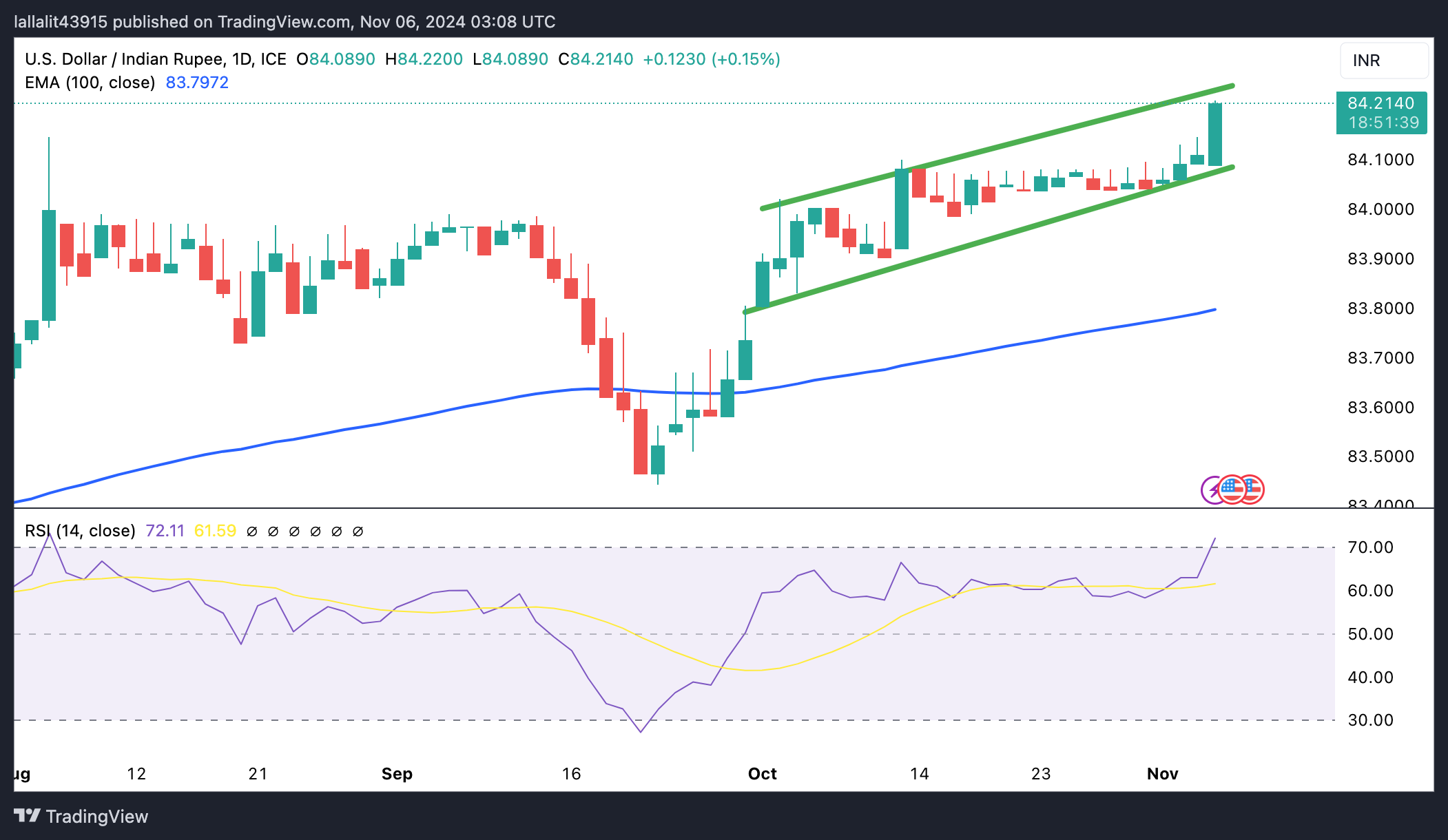- The Indian Rupee loses ground in Thursday’s early Europan session.
- The strengthening of the USD and higher bond yields might cap the INR’s upside.
- The US Fed interest rate decision will take center stage on Thursday.
The Indian Rupee (INR) loses momentum on Thursday. A rally in the US Dollar (USD) and higher bond yields after Donald Trump’s victory in the US presidential elections support the pair. Market participants expect the INR to trade in the range on Thursday as the Reserve Bank of India (RBI) is expected to intervene in the market by selling the USD to avoid excess volatility.
Meanwhile, persistent foreign fund outflows amid bond and foreign exchange volatility could exert some selling pressure on the INR in the near term. Investors will closely monitor the US Federal Reserve (Fed) meeting on Thursday, which is expected to cut interest rates by 25 basis points (bps). Also, the US weekly Initial Jobless Claims will be released.
Daily Digest Market Movers: Indian Rupee edges lower, with all eyes on Fed meeting
- “The rupee was trading in a narrow range for the past two years, and was a bit overvalued too. But now given that the dollar index is rising and other Asian currencies are depreciating, there will be an impact on the rupee too,” noted Gopal Tripathi, head of treasury and capital markets, Jana Small Finance Bank.
- The HSBC India Services PMI rose to 58.5 in October from 57.7 in September, exceeding a preliminary estimate of 58.3.
- "During October, the Indian services sector experienced strong expansions in output and consumer demand, as well as job creation," noted Pranjul Bhandari, chief India economist at HSBC.
- A narrow majority of economists in a Reuters poll expected the RBI to cut rates by 25 bps to 6.25% in December.
- Financial markets are now pricing in nearly a 98% possibility of a quarter point reduction and near 70% odds of a similar-sized move in December, according to CME's FedWatch tool. However, traders have begun to trim bets for the number of rate cuts expected next year.
Technical Analysis: USD/INR’s constructive outlook remains unchanged, eyes on overbought RSI
The Indian Rupee recovers on the day. Technically, the positive view of the USD/INR pair prevails as the pair holds above the key 100-day Exponential Moving Average (EMA) on the daily timeframe. However, the 14-day Relative Strength Index (RSI) stands above the midline near 73.45, indicating the overbought RSI condition. This suggests that further consolidation cannot be ruled out before positioning for any near-term USD/INR appreciation.
The crucial resistance level for USD/INR emerges near the upper boundary of the ascending trend channel at 84.30. The additional upside filter to watch is 84.50, followed by the 85.00 psychological level.
On the flip side, the lower limit of the trend channel and the high of October 11 in the 84.05-84.10 zone act as an initial support level for the pair. A breach of this level could pave the way to 83.80, the 100-day EMA. Extended losses could see a drop to 83.46, the low of September 24.
RBI FAQs
The role of the Reserve Bank of India (RBI), in its own words, is "..to maintain price stability while keeping in mind the objective of growth.” This involves maintaining the inflation rate at a stable 4% level primarily using the tool of interest rates. The RBI also maintains the exchange rate at a level that will not cause excess volatility and problems for exporters and importers, since India’s economy is heavily reliant on foreign trade, especially Oil.
The RBI formally meets at six bi-monthly meetings a year to discuss its monetary policy and, if necessary, adjust interest rates. When inflation is too high (above its 4% target), the RBI will normally raise interest rates to deter borrowing and spending, which can support the Rupee (INR). If inflation falls too far below target, the RBI might cut rates to encourage more lending, which can be negative for INR.
Due to the importance of trade to the economy, the Reserve Bank of India (RBI) actively intervenes in FX markets to maintain the exchange rate within a limited range. It does this to ensure Indian importers and exporters are not exposed to unnecessary currency risk during periods of FX volatility. The RBI buys and sells Rupees in the spot market at key levels, and uses derivatives to hedge its positions.
Information on these pages contains forward-looking statements that involve risks and uncertainties. Markets and instruments profiled on this page are for informational purposes only and should not in any way come across as a recommendation to buy or sell in these assets. You should do your own thorough research before making any investment decisions. FXStreet does not in any way guarantee that this information is free from mistakes, errors, or material misstatements. It also does not guarantee that this information is of a timely nature. Investing in Open Markets involves a great deal of risk, including the loss of all or a portion of your investment, as well as emotional distress. All risks, losses and costs associated with investing, including total loss of principal, are your responsibility. The views and opinions expressed in this article are those of the authors and do not necessarily reflect the official policy or position of FXStreet nor its advertisers. The author will not be held responsible for information that is found at the end of links posted on this page.
If not otherwise explicitly mentioned in the body of the article, at the time of writing, the author has no position in any stock mentioned in this article and no business relationship with any company mentioned. The author has not received compensation for writing this article, other than from FXStreet.
FXStreet and the author do not provide personalized recommendations. The author makes no representations as to the accuracy, completeness, or suitability of this information. FXStreet and the author will not be liable for any errors, omissions or any losses, injuries or damages arising from this information and its display or use. Errors and omissions excepted.
The author and FXStreet are not registered investment advisors and nothing in this article is intended to be investment advice.
Recommended content
Editors’ Picks

AUD/USD: Extra gains need to clear 0.6400
AUD/USD rose for the third day in a row, approaching the key 0.6400 resistance on the back of the acute pullback in the US Dollar amid mounting recession concerns and global trade war fear.

EUR/USD: Powell and the NFP will put the rally to the test
EUR/USD gathered extra steam and advanced to multi-month peaks near 1.1150, although the move fizzled out somewhat as the NA session drew to a close on Thursday.

Gold looks offered near $3,100
Prices of Gold remain on the defensive on Thursday, hovering around the $3,100 region per troy ounce and retreating from earlier all-time peaks near the $3,170 level, all against the backdrop of investors' assessment of "Liberation Day".

Interoperability protocol hyperlane reveals airdrop details
The team behind interoperability protocol Hyperlane shared their upcoming token airdrop plans happening at the end of the month. The airdrop will occur on April 22, and users can check their eligibility to receive $HYPER tokens via a portal provided by the Hyperlane Foundation by April 13, the team shared in a press release with CoinDesk.

Trump’s “Liberation Day” tariffs on the way
United States (US) President Donald Trump’s self-styled “Liberation Day” has finally arrived. After four straight failures to kick off Donald Trump’s “day one” tariffs that were supposed to be implemented when President Trump assumed office 72 days ago, Trump’s team is slated to finally unveil a sweeping, lopsided package of “reciprocal” tariffs.

The Best brokers to trade EUR/USD
SPONSORED Discover the top brokers for trading EUR/USD in 2025. Our list features brokers with competitive spreads, fast execution, and powerful platforms. Whether you're a beginner or an expert, find the right partner to navigate the dynamic Forex market.




